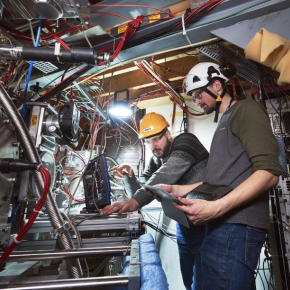Ultra-precise measurements of the mass of the indium-99 nucleus challenge nuclear physics models
The ISOLTRAP experiment at CERN, in which physicists from IN2P3 are participating, has taken advantage of a significant increase in precision to measure the minute difference in mass that distinguishes the magic nucleus of Indium 99 in its fundamental state from its excited equivalent (isomer). The unexpected result challenges the various existing nuclear models.
A nucleus gains greater stability than its neighbours when it has filled up on neutrons and/or protons in its various layers. Nuclear physicists call these nuclei 'magic'. This is the case for indium-99 and indium-131, which are full with their 50 and 82 neutrons respectively. This clear demonstration is used by nuclear physicists to understand the forces that govern the stability of the nucleus. To do this, they compare the intimate properties of the magic nuclei with those of their neighbouring isotopes.
Two observables for probing magic cores
This is what has been done, for example, with the measurement of magnetic moment. The magnetic moment is the average electromagnetic manifestation of the movement of all the charged constituents of a nucleus. Sudden variations in magnetic moment, observed between an isotope and its neighbours, are often interpreted as experimental indications of the existence of a magic nucleus. And indeed, this variation has been observed for indium-99 and indium-131 with their neighbouring isotopes. This finding is reinforced by the theoretical mean-field and ab initio models (which model the atomic nucleus by weaving close links with its smallest components, the quarks), which predict that indium-99 is a magic nucleus.
Just when everything seemed to form a coherent framework, a new study has come along to stir things up. David Lunney's team, researchers at IJCLab, decided to test this increased stability (expected for a magic nucleus) by relying on another observable of the phenomena at work at the heart of the nucleus: the variation in mass between the fundamental state of a nucleus and its 'stable' excited state, otherwise known as an isomer.
To do this, the team was able to rely on CERN's ISOLTRAP device, designed to measure the mass of nuclei by timing their comings and goings between two reflectors, and now capable of discerning extremely small gaps, such as the one that separates the mass of indium 99 in its fundamental state from that of its isomer. The lighter nuclei create a gap over the heavier ones, which increases as the race continues.
Contradictory results
Contrary to what was predicted for the magnetic moment, the mass difference between the ground state and the corresponding isomer remains comparable for indium isotopes 99, 100 and 101. In short, contrary to what the mean-field and ab initio models predict, a sudden variation in magnetic moment is not always a reliable indication of the existence of a magic system. The reason probably lies in the nature of nucleons. The completion of a layer of neutrons will not have the same impact on the stability of the nucleus as the completion of a layer of protons.
But the team is not stopping there, and is already proposing new avenues. Using a large-scale layered model, which offers a more phenomenological description compared with other models, Kamila Sieja, theorist at the IPHC, has managed to find the phenomenon and pinpoint the origin of this strangeness. It would appear to be the result of a subtle interaction between the states of protons and neutron occupations. In particular, this lead provides an excellent means of better refining other theoretical models, especially the more modern ones based on ab initio techniques, which guide us towards a better understanding of the interaction between the constituents of a nucleus. A fine demonstration of the fruitful dialogue between experimentalists and theoreticians in building a faithful model of nuclear interaction.
More information :
Link to the publication : Isomeric Excitation Energy for 99Inm from Mass Spectrometry Reveals Constant Trend Next to Doubly Magic 100Sn
Link to the Courrier Cern article : An even closer look at magic tin
